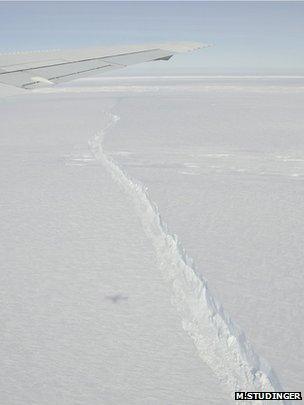Huge iceberg forms in Antarctica
- Published

Scientists are monitoring the birth of a monster iceberg in West Antarctica.
A rift has formed in the shelf of floating ice in front of the Pine Island Glacier (PIG).
The surface crack in the PIG runs for almost 30km (20 miles), is 60m (200ft) deep and is growing every day.
US space agency (Nasa) researchers expect the eventual iceberg to cover about 880 sq km - an area the size of Berlin. It should break away towards the end of the year or early in 2012.
Pine Island Glacier is one of the largest and fastest-moving tongues of ice on the White Continent and drains something like 10% of all the ice flowing out of the West Antarctic Ice Sheet into the ocean.
In recent years, satellite and airborne measurements have recorded a marked thinning of the PIG, which may be related to climate changes.
But the team working on Nasa's IceBridge project say this latest birthing of a giant iceberg is part of a natural cycle seen every 10 years or so on the glacier.
"The last big calving event occurred in 2001 so in general people have been expecting something like this to happen fairly soon, and for us it is very exciting to see this while it is happening," said IceBridge project scientist Dr Michael Studinger.
An iceberg of the size expected will need to be monitored carefully, and not just because it could eventually become a hazard to shipping.
The biggest icebergs can have a major impact on their surroundings.
As they crumble and melt, they dump millions of tonnes of freshwater into the local marine environment. Dust and rock fragments picked up on land act as nutrients when they fall into the ocean, fuelling life such as algae and diatoms right at the bottom of food webs. But these huge tabular blocks can also put obstacles in the way of animals trying to get to familiar feeding grounds.
"Eventually, the iceberg will move further north; it will be picked up by wind and ocean currents - and the primary ocean current there is the Antarctic Circumpolar Current. We will certainly be following it," Dr Studinger told BBC News.
IceBridge is running a series of instrumented airborne campaigns to measure the thickness of ice in Earth's polar regions. The "bridge" in its name refers to the data that must be gathered to fill the gap between Nasa's now defunct Icesat laser altimeter spacecraft and the future Icesat-2 mission due to come into operation later this decade.
- Published11 August 2011
- Published9 August 2011
- Published15 December 2010
- Published7 August 2010
- Published26 February 2010